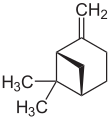lemon oil
| safety instructions | ||||||||||
|---|---|---|---|---|---|---|---|---|---|---|
| Surname |
Lemon oil from Citrus limon (L.) Burm f. |
|||||||||
| CAS number |
84929-31-7 |
|||||||||
| EC number |
284-515-8 |
|||||||||
| ECHA InfoCard | ||||||||||
|
||||||||||
| Toxicological data | ||||||||||
Lemon oil is a slightly yellowish, pleasant and characteristic smelling and tasting essential oil that is extracted from lemon peel .
composition
The main ingredient is (+) limonene (over 65%), other ingredients are β- pinene (10%), γ-terpinene (10%) and the citral (3–5%, mixture of geranial and neral ) responsible for the characteristic scent ).
Citral A (Geranial)
The density is 0.852–0.856 g · ml −1 and the boiling range 179–181 ° C at normal pressure.
Manufacturing
Lemon oil is obtained by squeezing lemon peel , the yield is between 30 and 60%. In 2001, Germany imported lemon oil from the following countries of origin: Italy (77 tons), Spain (22 tons) and Argentina (21 tons). In Argentina, the production takes place in the world's largest cultivation area around Tucuman . The Coca-Cola Company is the world's largest customer .
use
Lemon oil is used to give or improve flavor in the aroma industry , in perfumery , in the food industry, in pharmaceutical preparations and in the fragrance lamp for room scenting. Lemon oil was used to lighten the specimen in microscopy. Due to photodermatitis and possible skin sensitization effects, lemon oil should not be used on the skin (or only very diluted) . Lemon oil is also used to clean guitar fingerboards.
Individual evidence
- ↑ a b c d data sheet lemon oil at Sanabio , accessed on June 13, 2016.
- ↑ Entry on lemon oil. In: Römpp Online . Georg Thieme Verlag, accessed on June 15, 2014.
- ↑ a b Brockhaus ABC chemistry. FA Brockhaus Verlag Leipzig 1965, p. 1572.
- ^ Beatriz Stein: The citrus industry in Northwestern Argentina.










